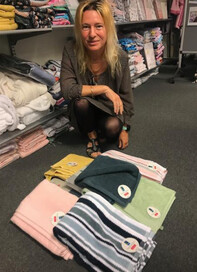In conversation with Linda Marielle Andreasse, Quality Manager at Princess, Norway.
Princess is a retail company that has about 150 stores in Norway. It was established in 1957 and the first store was opened in 1969. They have a long tradition and knowledge about home textiles and is one of the largest home textile brand in Norway.

Q.Tell us about your brand journey and what makes it sustainable?
A. Early 2007 we acknowledged that chemicals in home textiles could be potentially harmful to humans, and we started a massive work to take control over our supply chain and chemical control. We saw it beneficial both for our customers and us that our products also was environmentally friendly as we have a responsibility both to our customers, environment and the people that actually manufacture our products. Since 2007 we have worked on several areas when it comes to these matters,and increased our sustainable collection rapidly the last few years.
Q.How many certified labels does Princess work with. Do you find them complimentary or compatible with each other?
A. As to date we have approx. 6 different labels. We find that one do not rule out the other. We feel we have managed to get a good mix of certified labels that works good with our strategic plan and our long-term plan of a sustainable mix. We also are working on additional certified labels for the future. Our Goal is that in 2021 50% of our textile products shall be sustainable.
Q.How long have Princess been working with Fairtrade and what was the one facet that got this partnership started?
A. We have been working with Fairtrade since late 2017. We started the partnership because we felt this is a well recognized organization that
work for transparency and improvement of workers rights which is important to us and our company strategy.
Q.How many Fairtrade Cotton Producers in Asia does Princess source from? What is the annual volume off-take and how do you see the trend going forward?
A. We are currently working with 3 producers and we are increasing the product volume in the future. We see the trend as positive and that our customers also appreciate the opportunity to buy products that take workers rights seriously.
Q.In terms of quality and volume what does the brand expect from its supply chain partners?
A. Obviously, we expect good quality from our supply chain partners as our customers expect high quality when they shop in our stores. In volume terms we need our suppliers to be able to deliver the volume the customers demand in the future.
Q.What are your global sales volume of Fairtrade garments both Online and Retail? Do you see a trend in consumer awareness and preferences for ethically sourced products?
A. In 2018 which was out first year selling Fairtrade products our volume sales was approx. 5 mill NOK, which is quite good considering we started only selling these products in May/ June 2018.
Yes we see a positive trend in customer awareness for sustainable products, but it has been a slow start considering that we started the job 12 years ago with chemical control and sustainable organic products, but we also notice that a lot have happened the last 2-3 years, and that more customers ask for sustainable products and are more aware and conscious about what they buy.
Q.How much part does pricing play in influencing consumer choices for your products?
A.Pricing is important to our customers, we notice that if the price is similar to our regular products the customers tend to choose sustainable products. The Customers want to buy sustainable if the price is right.
Q.How many Fairtrade labelled products do you have currently? Which are your main markets and do you see any potential in expanding to the Global south?
A. Currently we have both towels and bed sets, which is two product categories that is our target markets. Our main market is Norway and since we only sell in Norway we will not expand in other markets, but hopefully we can increase the variety and volume of Fairtrade products in the future.
Q.How do you think big brands can influence the purchasing power of consumers? which in turn can support cotton producers to better access the global market?
A. I think we have a great opportunity to influence our customers in their consumer habits by providing a variety of sustainable products, and make sure they get information and about the added value they get by buying these products through the use of different marketing tools.
Q.How can NAPP extend its support for further strengthening the supply chain? Any particular segment you would like to see the focus on?
A. I think they can be better on providing information about what is the benefits of buying products that are Fairtrade labeled, whereby we as a retailer can provide our customers with adequate information. System and report wise it would be helpful if there is an easier way to show the transparency of the supply chain from the farmers to the consumer, also the system for us as retailers need to be a bit more easy handled in the future.



